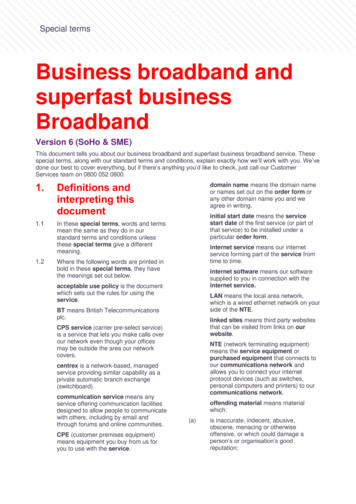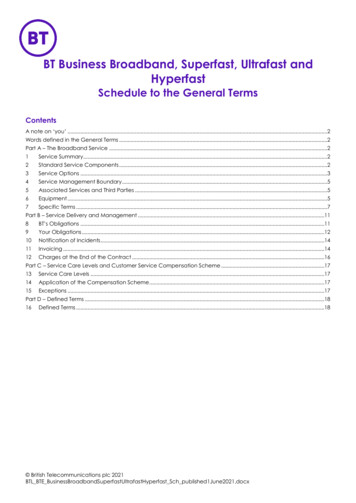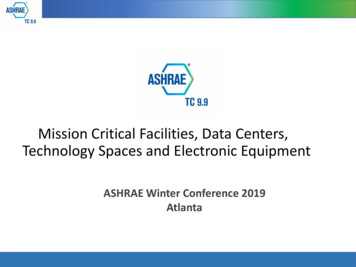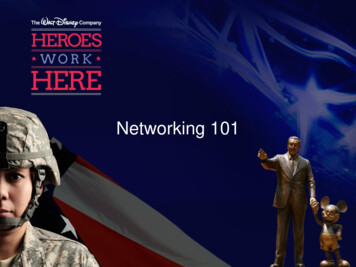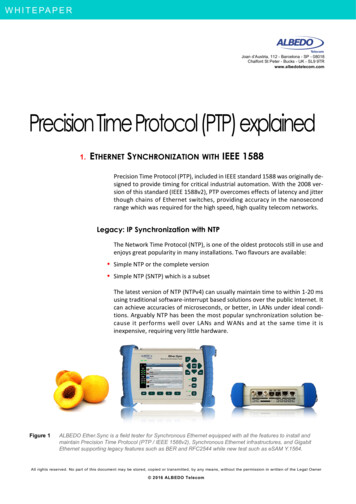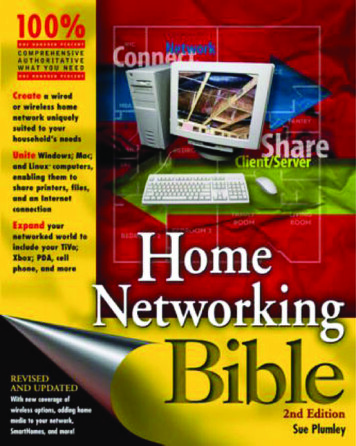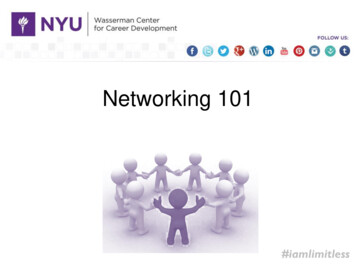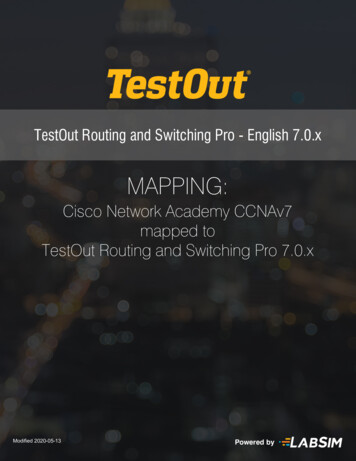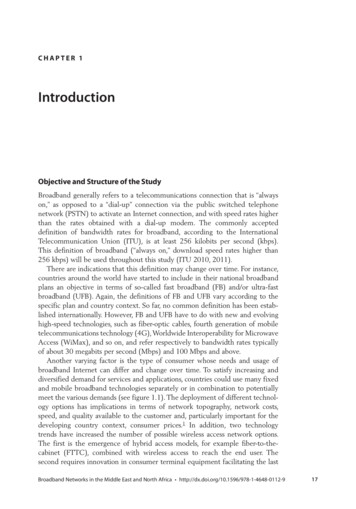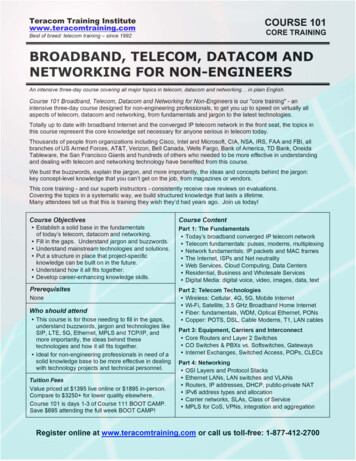
Transcription
Teracom Training Institutewww.teracomtraining.comCOURSE 101CORE TRAININGBest of breed: telecom training – since 1992BROADBAND, TELECOM, DATACOM ANDNETWORKING FOR NON-ENGINEERSAn intensive three-day course covering all major topics in telecom, datacom and networking in plain English.Course 101 Broadband, Telecom, Datacom and Networking for Non-Engineers is our "core training" - anintensive three-day course designed for non-engineering professionals, to get you up to speed on virtually allaspects of telecom, datacom and networking, from fundamentals and jargon to the latest technologies.Totally up to date with broadband Internet and the converged IP telecom network in the front seat, the topics inthis course represent the core knowledge set necessary for anyone serious in telecom today.Thousands of people from organizations including Cisco, Intel and Microsoft, CIA, NSA, IRS, FAA and FBI, allbranches of US Armed Forces, AT&T, Verizon, Bell Canada, Wells Fargo, Bank of America, TD Bank, OneidaTableware, the San Francisco Giants and hundreds of others who needed to be more effective in understandingand dealing with telecom and networking technology have benefited from this course.We bust the buzzwords, explain the jargon, and more importantly, the ideas and concepts behind the jargon:key concept-level knowledge that you can’t get on the job, from magazines or vendors.This core training - and our superb instructors - consistently receive rave reviews on evaluations.Covering the topics in a systematic way, we build structured knowledge that lasts a lifetime.Many attendees tell us that this is training they wish they’d had years ago. Join us today!Course ObjectivesCourse Content Establish a solid base in the fundamentalsof today’s telecom, datacom and networking. Fill in the gaps. Understand jargon and buzzwords. Understand mainstream technologies and solutions. Put a structure in place that project-specificknowledge can be built on in the future. Understand how it all fits together. Develop career-enhancing knowledge skills.Part 1: The Fundamentals Today’s broadband converged IP telecom network Telecom fundamentals: pulses, modems, multiplexing Network fundamentals: IP packets and MAC frames The Internet, ISPs and Net neutrality Web Services, Cloud Computing, Data Centers Residential, Business and Wholesale Services Digital Media: digital voice, video, images, data, textPrerequisitesPart 2: Telecom Technologies Wireless: Cellular, 4G, 5G, Mobile Internet Wi-Fi, Satellite, 3.5 GHz Broadband Home Internet Fiber: fundamentals, WDM, Optical Ethernet, PONs Copper: POTS, DSL, Cable Modems, T1, LAN cablesNoneWho should attend This course is for those needing to fill in the gaps,understand buzzwords, jargon and technologies likeSIP, LTE, 5G, Ethernet, MPLS and TCP/IP, andmore importantly, the ideas behind thesetechnologies and how it all fits together. Ideal for non-engineering professionals in need of asolid knowledge base to be more effective in dealingwith technology projects and technical personnel.Tuition FeesValue priced at 1395 live online or 1895 in-person.Compare to 3250 for lower quality elsewhere.Course 101 is days 1-3 of Course 111 BOOT CAMP.Save 695 attending the full week BOOT CAMP!Part 3: Equipment, Carriers and Interconnect Core Routers and Layer 2 Switches CO Switches & PBXs vs. Softswitches, Gateways Internet Exchanges, Switched Access, POPs, CLECsPart 4: Networking OSI Layers and Protocol Stacks Ethernet LANs, LAN switches and VLANs Routers, IP addresses, DHCP, public-private NAT IPv6 address types and allocation Carrier networks, SLAs, Class of Service MPLS for CoS, VPNs, integration and aggregationRegister online at www.teracomtraining.com or call us toll-free: 1-877-412-2700
COURSE 101 BROADBAND, TELECOM, DATACOM AND NETWORKING FOR NON-ENGINEERSDemystify Buzzwords and JargonOne of the biggest challenges in telecommunications is dealing with all of the acronyms,abbreviations, jargon and buzzwords.The list goes on and on: Broadband, Ethernet, TCP/IP, SIP trunking, OSI, Layer 2, VoIP,Hosted PBX, DSL, OE, PRI, ILEC, POP, MAN, Wi-Fi, LAN, WAN It can be very frustrating sitting in meetings with these terms flying around and notunderstanding most of them particularly when someone asks your opinion.Plus, there is a second-order problem: even if you were to figure out all of the currentjargon and buzzwords, there will surely be more next month!The solution? Understand the fundamentals. Take the cover off the box and see what itdoes and how it works. Doing this, you’ll find out there are only four or five fundamentalideas in telecom, with ongoing incremental improvement in each area.Understand the FundamentalsOnce you understand the fundamentals, not only will the buzzwords and jargon bedemystified, you’ll have a solid knowledge base. In the future, if you’re not familiar withthe exact product someone is discussing, you’ll still know what they are talking about.We’ll begin with a big-picture view, identifying the different parts of the network,understanding how circuits are implemented by carriers, how carriers interconnect, andthe residential, business and wholesale services.We’ll make sure everyone is starting at the same level, with telecom essentials like howbits are represented using pulses on fiber and LAN cables, how bits are representedusing modems on wireless and coax systems, and the different kinds of multiplexing.Without bogging down on details, you’ll learn the mechanics of the broadband convergedtelecom network: IP packets carried in MAC frames, and how phone calls, television,images and text are digitized and carried in the IP packets.Understand the Technologies: Wireless, Fiber and CopperWith the fundamentals in place, we’ll understand the technologies for communicating overradio, fiber and copper wires, and the mainstream technologies in each area.In the wireless chapter, we’ll start with spectrum, then you’ll learn the components andoperation of a mobile cellular network, 4G LTE and 5G, mobile internet, fixed wirelessbroadband internet, Wi-Fi and satellites.In the fiber chapter, we’ll understand the basic principles of fiber and fiber cables,wavelengths, Optical Ethernet and PONs. For copper, you’ll learn how DSL and Cablemodems work, along with LAN cable categories and more.You’ll learn the kinds of equipment used, what each does, and how it all interconnects forphone calls and Internet traffic.Taking this course to understand the fundamental ideas and mainstream technologiesputs you back in control, with the confidence to contribute effectively.TERACOM TRAINING INSTITUTEPAGE 2
COURSE 101 BROADBAND, TELECOM, DATACOM AND NETWORKING FOR NON-ENGINEERSUnderstand the Telecom NetworkIn the not-too-distant future, the Internet and the Public Telephone Network will becomethe same thing, and all communications including phone calls, television and internettraffic will be in IP packets. A basic understanding of IP addresses and packets and whatrouters do is a cornerstone of modern telecommunications knowledge.Taking this course, you’ll fill the gaps in your knowledge of IP and packet networks, andfully understand the ideas of packets, IP addresses and routers. We’ll demystify DHCP,static and dynamic addresses, private and public addresses and Network AddressTranslation. You’ll also learn how everyone gets 18 billion billion IPv6 addresses.We’ll complete your knowledge with MPLS, understanding how MPLS is used as an IPpacket traffic management system, to implement Class of Service quality guarantees, andto implement business communication services called MPLS VPNs.Learn About Cloud Computing and Data CentersCloud computing and data centers are a mammoth business and one of the biggestgrowth areas in the telecom area today.To understand data centers, we’ll start by reviewing what the Internet actually is, and therole of ISPs. Then we’ll understand the web: client-server computing over the Internet,what a web server is, how it serves web pages to clients, and how back-end processing isneeded to do transactions and database operations like finding your bank balance andcreating a web page to send to you to display it.Then you’ll learn how the computing power necessary to support thousands or millions ofusers doing this is implemented in Data Centers with Cloud Computing infrastructure toallow scalability and fault-tolerance and how this service is sold as “Web Services” bythe likes of Amazon’s AWS and Microsoft Azure.With the Web Services business sector revenue at 50 billion per year and climbing,familiarity with Data Centers and Cloud Computing is career-enhancing knowledge.Gain Vendor-Independent Knowledge You Can Build OnThe knowledge you gain taking this renowned training course is vendor-independentfoundational knowledge in telecommunications, networks, IP, packets, fiber, wireless:fundamentals, technologies, standard practices, and how it all fits together.You will be able to build on this proven knowledge base to quickly get up to speed for aparticular project - then have the versatility to work on subsequent projects.Not only will it eliminate buzzword frustration, the cost of this training will be repaid inimproved accuracy and productivity gain many times over.Teracom's proven instructor-led training courses have been developed and refined overmany years providing training for organizations including AT&T, Verizon, Bell Canada,Intel, Microsoft, Cisco, Qualcomm, the CIA, NSA, IRS, FAA, US Army, Navy, Marines andAir Force and hundreds of others and are totally updated for the 2020s.Register today to get this career-enhancing addition to your knowledge skills!TERACOM TRAINING INSTITUTEPAGE 3
COURSE 101 BROADBAND, TELECOM, DATACOM AND NETWORKING FOR NON-ENGINEERS4BHere's What Seminar Attendees Like You Are SayingHundreds of people like you have benefited from Teracom’s core training. Many tell us this was theirbest course ever; filled gaps in their knowledge and tied everything together knowledge they’ve beenneeding for years. Others on course their first week on the job remarked “what a wonderful way to getstarted in the business.”Here’s a sampling of comments from Teracom alumni:“Feedback from my team was TERRIFIC. It gave our entire technical Call Center a common foundation,and you seem to have crafted that perfect balance between technical depth, real-world applications, andlively delivery. I couldn't be happier with the results. The things my team learned from this training wereapplied in real-world situations almost immediately.”- Rusty Walther, Vice President, Client Services, AboveNet Communications“Excellent! I learned a lot - everyday terms, definitions, and acronyms. Seminar notebook very helpful.The instructor was the best I ever had – lots of knowledge and experience and stories were GREAT.”- Serena Laursen, Microsoft“Thank you for conducting a very successful course last week. It was both informative and interesting andyou were able to find the perfect balance of sharing deep knowledge, provide relatable examples andlighten it up with great humor. The feedback that we have received has been extremely positive.”- Charlotte Kaheru, International Finance Corporation, World Bank“The seminar delivered exactly what was advertised, at a very high quality.Truth in advertising!” - Gary Lundberg, Copper Mountain NetworksWhether you work for an organization that produces telecom, datacom or networking products or services; or youbuy these products and services - or just have to get up to speed on what all the rest of them are talking about whenthey say “SIP trunking”, “Ethernet”, “MAC frame”, 5G, MPLS, VPN, Data Center, Cloud Computing “Best course we have ever had onsite at 3Com”“Perfect content; well organized, well paced, building block approach,resulted in a very nice cathedral” - Jim George, Qualcomm“Course was excellent! One of the best I have taken. Extremely well organized and presented. Seminarworkbook is outstanding - a very valuable reference” - Kieran Delaney, Maritime Life“I liked most the use of analogies to explain complex concepts. It delivered exactly what the brochurepromoted. Gave me a thorough understanding so I feel more confident.”- Judith Myers, AT&T“Excellent! Tied the individual pieces of knowledge together into a picture was interactive and built upthe knowledge layers properly.” - Jim Geiss, Century Link“Filled in a lot of gaps in my knowledge of networking. able to deliver the knowledge effectively andentertainingly. Excellent seminar”- Kirk Kroeker, IEEE Computer Society“Layman's terms with humor was very relaxing - helped me concentrate. understanding is now CLEAR. the manual will be very helpful” - Linda Côté, Bell Canada“Best instructor I have had on a course - excellent explainer in layman terms, not techie terms”- Susan Coleman, Bell Sygma“Best course materials ever; the full text descriptions are invaluable.Course filled in so many gaps for me. Bravo!” - Ross Brooks, Vertek“Outstanding! The best I've encountered, and I've attended many seminars.”- Bob Gibbons, WMX TechnologiesTERACOM TRAINING INSTITUTEPAGE 4
COURSE 101 BROADBAND, TELECOM, DATACOM AND NETWORKING FOR NON-ENGINEERSSix Reasons to Take This CourseTeracom’s courses have been taught to wide acclaim across North America since 1992 andare designed for the non-engineering professional needing to fill in the gaps, build a solidbase of knowledge and see how it all fits together. Totally up to date for the 2020s!1. Cut through the jargon and vendor hype to gain a structured understanding of telecommunicationsand networking, allowing you to make informed choices and meaningful comparisons -knowledge you can't get on the job, reading trade magazines or talking to vendors, and aninvestment that will be repaid many times over.2. Eliminate buzzword frustration, be more confident, more accurate and more productive.3. Get up to speed on the latest developments and trends. This course is totally up to date with SIPtrunking, VoIP, 5G, Optical Ethernet, MPLS, Data Centers, Cloud Computing and more.4. Learn more with instructor-led training, where you can interact and ask questions – the best kindof training you can get – and instructors consistently rated “excellent” on student evaluations.5. Get Certifications: CTNS with Course 101; CTNS, CVA and CTA with BOOT CAMP.6. Get a 356-page high-quality color course book with copies of graphics plus detailed text notes,bringing together all of this information, impossible to find in one place anywhere else, sure to bea valuable reference for years.Course ScheduleWe’re constantly adding new dates. To see the latest schedule, please visit teracomtraining.com.Or have us come to you for a private on-site seminar!How to RegisterSpace in our seminars is limited, and may sell out, so please register as early as possible to reserve yourplace. Register online at teracomtraining.com, or call us at 1-877-412-2700. You will receive aregistration package with full details plus a confirmation letter to sign and return.Free Bonuses! Online Courses and TCO CertificationThe TCO Certified Telecommunications Network Specialist (CTNS) Certification Package, with its eightonline courses and exams is included as a free bonus with Course 101. The online courses are anexcellent way to take a second pass the topics, and include additional pictures of equipment anddiscussion. If you choose to write the optional exams, you can also earn the TCO CTNS certification,complete with certificate suitable for framing and letter of reference.If you attend BOOT CAMP (Course 101 and Course 130), the TCO Certified Telecommunications Analyst(CTA) and Certified VoIP Analyst (CVA) Certification Packages with their online courses are also includedas a free bonus!Your Course Materials: An Invaluable ReferenceNo-one expects anyone to learn all of this in one shot! For self-study and day-to-day reference, everycourse comes with a high-quality printed color course book that's been called the best on-the-jobreference tool around. Written in plain English, this easy-to-use reference includes copies of allgraphics PLUS extensive detailed text notes.Topics are organized in logical groups to give you easy reference to the practical experience,theoretical background, and unbiased information on industry technologies, products and trends youwill need. With numerous chapters covering all major topics, you'll obtain an invaluable resourceimpossible to find anywhere else in one book.Get a sneak preview of the course materials via the tutorials at www.teracomtraining.com.TERACOM TRAINING INSTITUTEPAGE 5
COURSE 101 BROADBAND, TELECOM, DATACOM AND NETWORKING FOR NON-ENGINEERSDetailed Course OutlineBroadband, Telecom, Datacom and Networking for Non-Engineers is our core training, representing theknowledge set needed by anyone in telecom today. Our philosophy is: start at the beginning.Understand the fundamental ideas. Understand mainstream technologies that implement these ideas.Learn the acronyms, abbreviations and jargon. Get an unbiased big-picture view that will give you theknowledge you need to ask the right questions, make meaningful comparisons and informed decisions.Our goal is to eliminate frustration, increase confidence, accuracy and productivity by building a solidvendor-independent knowledge base that has both immediate and long-term value.Part 1: FundamentalsThe first part of Course 101 is six chapters that cover the fundamentals of telecom, filling gaps,explaining concepts and establishing a solid knowledge base. First is a high-level pass with a bigpicture view and introducing all of the course topics. Then we progress in a logical order: how telecomcircuits are provisioned by carriers, telecom fundamentals, followed by IP packet networkfundamentals. Then you’ll learn about the Internet as a business: ISPs, web services like AWS, cloudcomputing and data centers. We’ll review today’s services in the residential, business and wholesalecategories. The fundamentals are completed with digital media: how voice is digitized, digital video,digital images, digital quantities and digital text.1. Introduction to Broadband Converged IP TelecommunicationsWe begin with a comprehensive big-picture introduction to broadband telecom: the conceptsof convergence and broadband, today’s telecom network, the parts of the network, the threekey technologies: Ethernet, IP and MPLS, what they are and what each does. You’ll learnhow a circuit is implemented end-to-end, and identify today’s standard residential, businessand wholesale services.A.B.C.D.E.F.G.H.I.J.K.L.History of TelecommunicationsConvergenceBroadbandToday’s Converged Telecom NetworkNetwork CoreEthernet, IP and MPLSNetwork Access: The Last MileAnatomy of a ServiceInside the Network CloudNetwork Edge EquipmentInterconnect to Other CarriersResidential, Business and Wholesale Services2. Telecom FundamentalsNext, we’ll ensure you have a solid foundation in the fundamental ideas of telecom: theelements of a circuit; terminals, clients, servers and peers; how bits are represented on fiberwith pulses; and how bits are represented with modems on wireless, cable TV and DSL.Then we’ll understand how capacity is shared to carry many users’ traffic on commonfacilities: Frequency Division Multiplexing, Time Division Multiplexing, overbooking andBandwidth on Demand.A.B.C.D.E.F.Communication Circuit ModelTerminals, Clients, Servers and PeersRepresenting Bits on Digital Circuits: PulsesRepresenting Bits in Frequency Channels: ModemsSerial and ParallelSharing: Frequency-Division MultiplexingTERACOM TRAINING INSTITUTEPAGE 6
COURSE 101 BROADBAND, TELECOM, DATACOM AND NETWORKING FOR NON-ENGINEERSG. Sharing: Channelized Time-Division Multiplexing (TDM)H. Efficient Sharing: Statistical Time Division MultiplexingI. Overbooking and Bandwidth on Demand3. Network FundamentalsIn this chapter, we’ll ensure you also have a solid foundation in the fundamentals and jargonof the network. Today’s converged telecom network is based on what used to be called“data communications”: packets in frames. Without bogging down on details, we’ll reviewbasic circuit configurations, understand how routers relay packets from one circuit toanother, and how the packets are actually transmitted from one device to another in frames.You’ll fill gaps and get up to speed on IP packets, MAC frames and MPLS labels, what eachis for and how they work together.A.B.C.D.E.F.G.H.Data Links – Unbalanced: PONs, CATV, Wi-Fi, CAN-BUSData Links – Balanced: LANs and EthernetFrames & MAC AddressesNetworksPackets, IP Addresses and RoutersIP Packets vs. MAC FramesIP PacketsMPLS Labels4. The Internet, Cloud Computing and Data CentersThe Internet, which started out as a way to send text email messages, is now worldwideconverged broadband communications. In this chapter, we’ll understand what exactly anInternet Service Provider does, and how they get packets delivered world-wide. We’ll reviewweb clients, browsers and apps, web servers, then understand the huge business of webservices, cloud computing and data centers.A.B.C.D.E.F.G.H.I.A Network to Survive Nuclear WarThe Inter-Net ProtocolInternet Service Providers (ISPs)Domain Name System (DNS)Web Clients: Browsers and AppsWeb Servers: HTTP, HTTPS, HTMLWeb Services and Cloud ComputingData CentersNet Neutrality5. Telecom Services OverviewNo foundation in telecom would be complete without understanding where the money is:services with recurring billing. We’ll organize services into Residential, Business andWholesale, and identify today’s standard choices and offerings in each area. We’ll coverBroadband Internet for residences, plus Internet VoIP with PSTN phone number, andstreaming video; in the business category VPNs, SD-WAN, SIP trunking, PRI and Centrex;and wholesale services dark fiber, wavelengths, Carrier Ethernet and IP transit.A.B.C.D.E.Residential ServicesBusiness “Data” Services: MPLS, VPNs & Internet, SD-WANBusiness Voice Services: SIP Trunking, PBX Trunks, PRI, CentrexWholesale ServicesContent Delivery NetworksTERACOM TRAINING INSTITUTEPAGE 7
COURSE 101 BROADBAND, TELECOM, DATACOM AND NETWORKING FOR NON-ENGINEERS6. Digital Media: Voice, Video, Images, Quantities, TextThe converged network carries all media: voice, video, text and images in packets. Anessential first step is digitizing the media, representing it using 1s and 0s, to be carried insaid packets. We’ll understand how voice is digitized and reconstructed, and the G.711 64kb/s standard. The same principles apply to images and video in formats like jpg and mp4video. We’ll review binary and hexadecimal, and finish with unicode for text and emojis.A.B.C.D.E.F.G.H.I.J.Analog and Digital: What Do We Really Mean?Continuous Signals, Discrete SignalsVoice Digitization (Analog Digital Conversion)Voice Reconstruction (Digital Analog Conversion)Digital Voice: 64kb/s G.711 StandardDigital Video: H.264 / MP4, HD, 4KDigital Images: JPG, GIF, PNGDigital Images in Emails: MIMEDigital Quantities: Binary and HexDigital Text: ASCII and UnicodePart 2: Telecom TechnologiesIn the second part of the course, we explore the three main technologies for transmitting informationfrom one place to another, grouped into wireless, fiber and copper. We'll cover wireless spectrum,mobile network components and operation, 4G LTE, 5G, fixed wireless broadband home internet, Wi-Fiand satellites. Then you'll learn optical basics, and how networks are built with point-to-point fibersrunning Optical Ethernet, wave-division multiplexing, fiber in the core, metro and to the premise. We'llfinish with copper-wire technologies: DSL and POTS on twisted pair, Hybrid Fiber-Coax cable TVsystems, T1 and the categories of LAN cables.7. WirelessIn this chapter, you will learn all about wireless transmission. We’ll identify the components andbasic principles of operation of a mobile network. You’ll understand the requirements forcoverage, capacity and mobility, and why cellular radio systems are used. You’ll learn howmobile to PSTN phone calls are connected, how mobile Internet works, roaming and virtualoperators. You’ll learn about 4G LTE and 5G for mobile, and fixed wireless broadband internet.We’ll cover WiFi and the latest 802.11ax standard, and finish with satellite communications.A. Radio FundamentalsB. SpectrumC. Mobile Network Components and Operation1. Towers2. Transceivers3. Backhaul4. Mobile Switches & MTSOsD. Cellular and HandoffsE. PSTN Phone Calls using the Phone App (“Voice Minutes”)F. Mobile Internet (“Data Plan”)G. Broadband Delivery: Cellular WiFiH. Mobile Operators, MVNOs and RoamingI. Spectrum-Sharing: FDMA, TDMA, CDMA, OFDMJ. 4G LTEK. 5G New Radio (NR)L. 3.5 GHz Fixed Wireless Broadband Home InternetM. WiFi: Wireless LANs & 802.11 StandardsN. LEO and GEO SatelliteTERACOM TRAINING INSTITUTEPAGE 8
COURSE 101 BROADBAND, TELECOM, DATACOM AND NETWORKING FOR NON-ENGINEERS8. Fiber OpticsThe core of the converged network is routers connected point-to-point to other routers withfiber. Telephone companies that used to pull copper access wires to every home in asuburb are investing to pull an access fiber to every home. In this chapter, we’ll cover thebasics of fiber, the makeup of fiber cables, wavelengths and WDM. You’ll understand howOptical Ethernet is used to actually implement the fiber connections, and how OE is used inthe core, in metro areas, and fiber to the premise via Passive Optical Networks (PONs).A.B.C.D.E.F.G.H.Fiber BasicsFiber Optics and Fiber CablesOptical Wavelengths, Bands and ModesWave-Division Multiplexing: CWDM and DWDMOptical EthernetThe Network CoreMetropolitan Area NetworksFiber to the Premise (FTTP, FTTH): PONs and Optical Ethernet9. CopperBefore wireless and fiber, two copper wires were used as the physical access circuit fortelephone and cable TV service in suburbs and cities. Today, these wires are used to deliverbroadband. In this chapter, we’ll understand how DSL broadband service runs on twistedpairs put in place for analog POTS telephone service; how cable modems move broadbandon coaxial cable; and how both are delivered as fiber to the neighborhood then copper to thepremise. To finish up, we’ll review digital on copper wires: LAN cables and T1s.A.B.C.D.E.F.G.H.I.J.K.L.M.The Public Switched Telephone Network (PSTN)Analog CircuitsThe VoicebandPlain Ordinary Telephone Service (POTS)DTMF Address SignalingDSL: Beyond the VoicebandDSLAMsFiber to the Neighborhood (FTTN), DSL to the PremiseVDSL2 Bands and ProfilesBroadband Carriers: FTTN & Broadband Coax to the PremiseDOCSIS and Cable Modem StandardsT1 and E1LAN Cables and CategoriesTERACOM TRAINING INSTITUTEPAGE 9
COURSE 101 BROADBAND, TELECOM, DATACOM AND NETWORKING FOR NON-ENGINEERSPart 3: Equipment, Carriers and InterconnectIn the third part of the course, we explore the equipment that is connected by the fiber, copperand wireless of Part 2 to form networks, and the place and purpose of each. Then weunderstand where and how connections physically take place for PSTN phone calls, forInternet traffic and CLEC services.10. Telecom EquipmentIn this chapter, we review the different types of telecom equipment, beginning with theessentials of the broadband telecom network: Ethernet switches and IP/MPLS routers,comparing costs and capabilities. Then, we’ll review the different types of customer premiseequipment for broadband. To explain soft switches, call managers and SIP servers, we’llbegin with legacy CO switches and PBXs to see the fundamental differences. Gatewaysand how they convert packets to channels completes the chapter.A.B.C.D.E.Broadband Network Equipment: Routers and Ethernet SwitchesBroadband Customer Premise EquipmentCO Switches, PBXs and RemotesSoft Switches, Call Managers and SIP ServersGateways11. Carriers and InterconnectTo allow communications between customers of different carriers, the carriers mustimplement physical connections between their networks. In this chapter, you’ll learn howthe Internet is actually implemented, with peering and transit agreements at InternetExchange buildings. You will also learn about POPs in toll centers: how and where localexchange service providers: ILEC, mobile providers and CATV connect together and toother carriers for phone calls with a PSTN phone number; and SS7 to set up the calls. We’llfinish by understanding where a CLEC fits into the picture with equipment collocated in wirecenters.A.B.C.D.E.F.G.H.IX: Interconnect for Internet TrafficToll Center: Interconnect for PSTN Telephone CallsImplementing Long-Distance Competition: LECs and IXCsSwitched Access and POPsWireless and CATV Local Exchange CarriersCOs and Wire CentersCLEC: Local Competition – Collocation plus ILEC Dark FiberSS7Part 4: NetworkingThe fourth and final part of Course 101 is devoted to IP networking and MPLS. We beginwith the OSI Reference Model and its layers to provide a structure for the discussion: what alayer is, what the layers are, the functions of each, and the standard protocols at each layer.Next is a chapter on Layer 2: Ethernet, 802 standards, broadcast domains and VLANs.Then, Layer 3: IP routers, IP addresses, DHCP, public and private addresses, NetworkAddress Translation and IPv6. Chapter 15 covers the core traffic management systemMPLS, and how MPLS is used to implement VPNs, classes of service, service integrationand traffic aggregation. We’ll conclude with a top-down review and roundup of technologiesand a peek at the future of telecommunications.TERACOM TRAINING INSTITUTEPAGE 10
COURSE 101 BROADBAND, TELECOM, DATACOM AND NETWORKING FOR NON-ENGINEERS12. The OSI Layers and Protocol StacksThere are so many functions that must be performed to interoperate systems, a structure isrequired to organize the functions so that separate issues can be treated separately. We’llbegin the fourth part of the course with the most commonly-used structure, the ISO OpenSystems Interconnectio
COURSE 101 BROADBAND, TELECOM, DATACOM AND NETWORKING FOR NON-ENGINEERS TERACOM TRAINING INSTITUTE PAGE 3 Understand the Telecom Network In the not-too-distant future, the Internet and the Public Telephone Network will become the same thing, and all communications including pho
